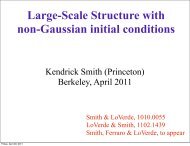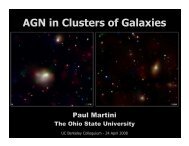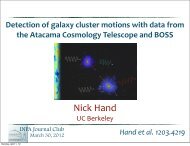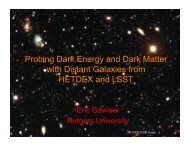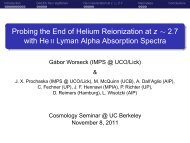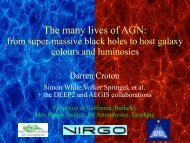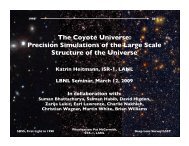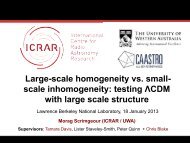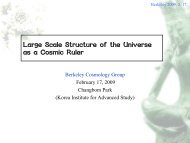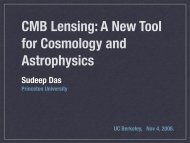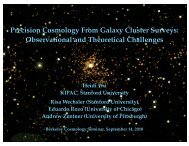Baryonic and Non-Baryonic Dark Matter in Massive Galaxies
Baryonic and Non-Baryonic Dark Matter in Massive Galaxies
Baryonic and Non-Baryonic Dark Matter in Massive Galaxies
Create successful ePaper yourself
Turn your PDF publications into a flip-book with our unique Google optimized e-Paper software.
<strong>Baryonic</strong> <strong>and</strong><br />
<strong>Non</strong>-<strong>Baryonic</strong> <strong>Dark</strong> <strong>Matter</strong>:<br />
Halo Contraction <strong>and</strong> the IMF<br />
Matt Auger<br />
UC Santa Barbara<br />
Tommaso Treu, Raphael Gavazzi, Adam Bolton,<br />
Leon Koopmans, Phil Marshall
Refra<strong>in</strong>:<br />
Strong Gravitational<br />
Lens<strong>in</strong>g
Background Source Multiply-Imaged by<br />
<strong>Massive</strong> Foreground Galaxy<br />
Image Separation<br />
depends on:<br />
- lens <strong>and</strong> source<br />
redshifts (geometry)<br />
- lens<strong>in</strong>g galaxy<br />
mass
First Verse:<br />
The Sloan Lens ACS<br />
(SLACS) Survey
SLACS Strong Lens<br />
Factory<br />
Late-type Background Source<br />
Early-type Foreground Lens
[OII] from<br />
source<br />
Ca K&H<br />
from Lens<br />
SLACS Strong Lens<br />
Factory
Second Verse:<br />
Properties of Early-Type<br />
<strong>Galaxies</strong>
ETGs show remarkably tight scal<strong>in</strong>g<br />
relations between size, velocity<br />
dispersion <strong>and</strong> ...<br />
FP M*P MP<br />
Surface<br />
brightness<br />
Stellar mass<br />
density<br />
Total mass<br />
density
Hyper-plane Relations<br />
Relationship between:<br />
- size<br />
- velocity dispersion<br />
- total mass <strong>in</strong> R e/2<br />
- stellar mass<br />
Consistent with no <strong>in</strong>tr<strong>in</strong>sic scatter,<br />
no dependence on stellar mass
More <strong>Massive</strong> <strong>Galaxies</strong> have More<br />
Central <strong>Dark</strong> <strong>Matter</strong><br />
M/L<br />
mass<br />
Total M/L<br />
`dark' matter<br />
Stellar M/L<br />
<strong>Dark</strong> <strong>Matter</strong> could be CDM or could be<br />
baryons not described by the IMF
Third Verse:<br />
The Important Physical<br />
Properties <strong>and</strong><br />
Mechanisms
Three Key Ingredients<br />
- Star-formation efficiency (mass dependent)<br />
- <strong>Dark</strong> matter (response to baryons?)<br />
- IMF (mass-dependent ??)
Star Formation Efficiency<br />
Satellite k<strong>in</strong>ematics<br />
<strong>and</strong> weak lens<strong>in</strong>g<br />
broadly confirm the<br />
expected trends of<br />
decreased eff. at<br />
high <strong>and</strong> low mass<br />
due to feedback<br />
from AGN <strong>and</strong> stars<br />
Increas<strong>in</strong>g<br />
efficiency<br />
Dutton et al 2010
Abundance Match<strong>in</strong>g<br />
Moster et al 2010
Cold <strong>Dark</strong> <strong>Matter</strong> Halo<br />
NFW Halos from<br />
N-body Simulations<br />
ETGs are dom<strong>in</strong>ated by baryons<br />
at small radii
Cold <strong>Dark</strong> <strong>Matter</strong> Halo<br />
Cool<strong>in</strong>g of baryons causes<br />
the halo to contract<br />
Gned<strong>in</strong> et al 2004
Cold <strong>Dark</strong> <strong>Matter</strong> Halo<br />
Abadi et al 2009<br />
Halo contraction may<br />
depend on the amount<br />
of baryons <strong>and</strong> how<br />
the baryons got there<br />
Dynamical friction can<br />
`puff up' halos...
A Universal IMF?<br />
The term `IMF' will<br />
describe the<br />
normalization but<br />
not the shape (ie<br />
`Salpeter' means<br />
`massive' but not<br />
necessarily `bottom<br />
heavy')
A Universal IMF?<br />
α = Log[ M*,Lens / M*,IMF ]<br />
Mass-dependent IMF?<br />
Treu et al 2010
Diagnos<strong>in</strong>g the IMF<br />
- Supernova Rates (top heavier IMF will<br />
have more core collapse)<br />
- Metallicities (which can be used as a<br />
proxy for SN rates)**<br />
- Microlens<strong>in</strong>g<br />
- Structural `weigh<strong>in</strong>g' of baryons
Fourth Verse:<br />
Constra<strong>in</strong><strong>in</strong>g a Galaxy<br />
Model with the Full<br />
SLACS Dataset
Model Mass Profile<br />
Bulge either Hernquist or Jaffe<br />
-> different central slopes!<br />
Halo either NFW, adiabatically<br />
contracted, or `generalized' NFW<br />
-> different central slopes!
Model Scal<strong>in</strong>g Relations<br />
Bulge <strong>and</strong> Halo mass related by a<br />
broken power-law relationship:<br />
SPS (IMF-dependent) <strong>and</strong> `true'<br />
stellar mass related by:<br />
low/high-mass slopes set<br />
to values from abundance<br />
match<strong>in</strong>g results
Data Products<br />
- Stellar velocity dispersions (probes 3d<br />
potential)<br />
- SPS stellar masses (probes bulge, IMFdependent)<br />
- Strong lens<strong>in</strong>g masses (very precise<br />
probe of projected central mass)<br />
- Weak lens<strong>in</strong>g shear measurements<br />
(probes outer projected mass distribution)
ρ * r 2<br />
Current Constra<strong>in</strong>ts<br />
Reff<br />
Re<strong>in</strong><br />
-20<br />
267<br />
284 282 269<br />
r<br />
190<br />
269<br />
228<br />
234
`lighter'<br />
IMF<br />
Current Constra<strong>in</strong>ts<br />
`non-universal'<br />
IMF is mass-dependent if NFW halo is<br />
assumed – <strong>and</strong> `bottom-light' ruled out
CODA<br />
- SLACS lenses are representative of<br />
ETGs <strong>in</strong> general<br />
- ETGs follow a `most'-Fundamental<br />
Relationship that does not depend<br />
significantly on the stellar mass
CODA<br />
- Structurally dist<strong>in</strong>guish<strong>in</strong>g between<br />
cold dark matter <strong>and</strong> baryonic mass <strong>in</strong><br />
massive galaxies favors either:<br />
- a non-universal IMF or<br />
- a non-NFW CDM halo
Bonus Track:<br />
M<strong>in</strong><strong>in</strong>g for Red Nuggets by<br />
Sniggl<strong>in</strong>g for EELs
Red Nuggets:<br />
Small massive galaxies at z ~ 1-2<br />
size<br />
mass<br />
Damjanov et al. 2009
EELs:<br />
Early-type/Early-type Strong Lenses
EELs:<br />
Early-type/Early-type Strong Lenses<br />
Isothermal lens<br />
E<strong>in</strong>ste<strong>in</strong> radius<br />
is ~0.4”; SDSS<br />
see<strong>in</strong>g is 1.4”<br />
z lens = 0.4, z src = 0.63
Us<strong>in</strong>g Laser Guide Star Adaptive<br />
Optics for Lens<strong>in</strong>g Studies<br />
HST H-b<strong>and</strong> Keck LGS-AO K-b<strong>and</strong><br />
Lagattuta et al 2010
Are EELs Red Nuggets?<br />
1”<br />
S<strong>in</strong>gle Sersic<br />
R = 0.5kpc<br />
M* = 10 10.9 M sun<br />
Double Sersic<br />
R = 1.1kpc
EELs:<br />
Small massive galaxies at z ~ 0.6<br />
EEL
EELs:<br />
E<strong>in</strong>ste<strong>in</strong>-radii Especially Little?<br />
0.62”<br />
7 EELs observed with<br />
LGSAO (all are lenses)<br />
~1.4” separation for<br />
largest system<br />
typical radii ~0.5”
EELs:<br />
Extra-Enhanced L<strong>in</strong>e-of-Sight?<br />
SLACS J0946<br />
Double-E<strong>in</strong>ste<strong>in</strong><br />
r<strong>in</strong>gs – with two<br />
sources at different<br />
redshifts – are a<br />
unique probe of<br />
dark energy!
Future Prospects of EELs<br />
- Red nuggets<br />
-- ~100pc source plane resolution<br />
-- magnification of LSB w<strong>in</strong>gs<br />
- Small E<strong>in</strong>ste<strong>in</strong> radii<br />
-- probes mass on small physical scales<br />
- Double-E<strong>in</strong>ste<strong>in</strong> r<strong>in</strong>gs<br />
-- super-massive LOS<br />
-- cosmological/galaxy evolution




